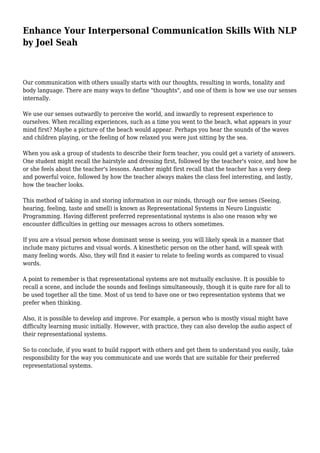
Enhance Your Interpersonal Communication Skills With NLP by Joel Seah
- 1. Enhance Your Interpersonal Communication Skills With NLP by Joel Seah Our communication with others usually starts with our thoughts, resulting in words, tonality and body language. There are many ways to define "thoughts", and one of them is how we use our senses internally. We use our senses outwardly to perceive the world, and inwardly to represent experience to ourselves. When recalling experiences, such as a time you went to the beach, what appears in your mind first? Maybe a picture of the beach would appear. Perhaps you hear the sounds of the waves and children playing, or the feeling of how relaxed you were just sitting by the sea. When you ask a group of students to describe their form teacher, you could get a variety of answers. One student might recall the hairstyle and dressing first, followed by the teacher's voice, and how he or she feels about the teacher's lessons. Another might first recall that the teacher has a very deep and powerful voice, followed by how the teacher always makes the class feel interesting, and lastly, how the teacher looks. This method of taking in and storing information in our minds, through our five senses (Seeing, hearing, feeling, taste and smell) is known as Representational Systems in Neuro Linguistic Programming. Having different preferred representational systems is also one reason why we encounter difficulties in getting our messages across to others sometimes. If you are a visual person whose dominant sense is seeing, you will likely speak in a manner that include many pictures and visual words. A kinesthetic person on the other hand, will speak with many feeling words. Also, they will find it easier to relate to feeling words as compared to visual words. A point to remember is that representational systems are not mutually exclusive. It is possible to recall a scene, and include the sounds and feelings simultaneously, though it is quite rare for all to be used together all the time. Most of us tend to have one or two representation systems that we prefer when thinking. Also, it is possible to develop and improve. For example, a person who is mostly visual might have difficulty learning music initially. However, with practice, they can also develop the audio aspect of their representational systems. So to conclude, if you want to build rapport with others and get them to understand you easily, take responsibility for the way you communicate and use words that are suitable for their preferred representational systems.